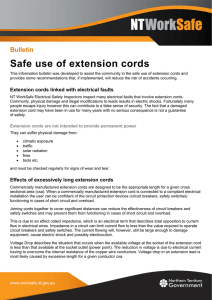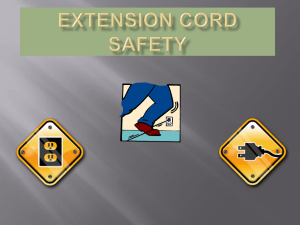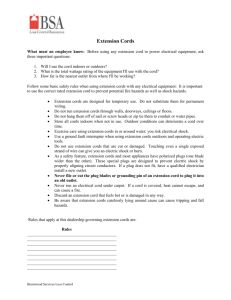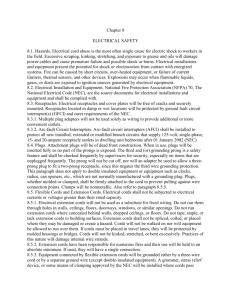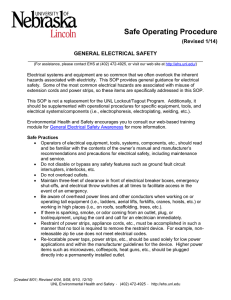Safe use of extension cords
advertisement
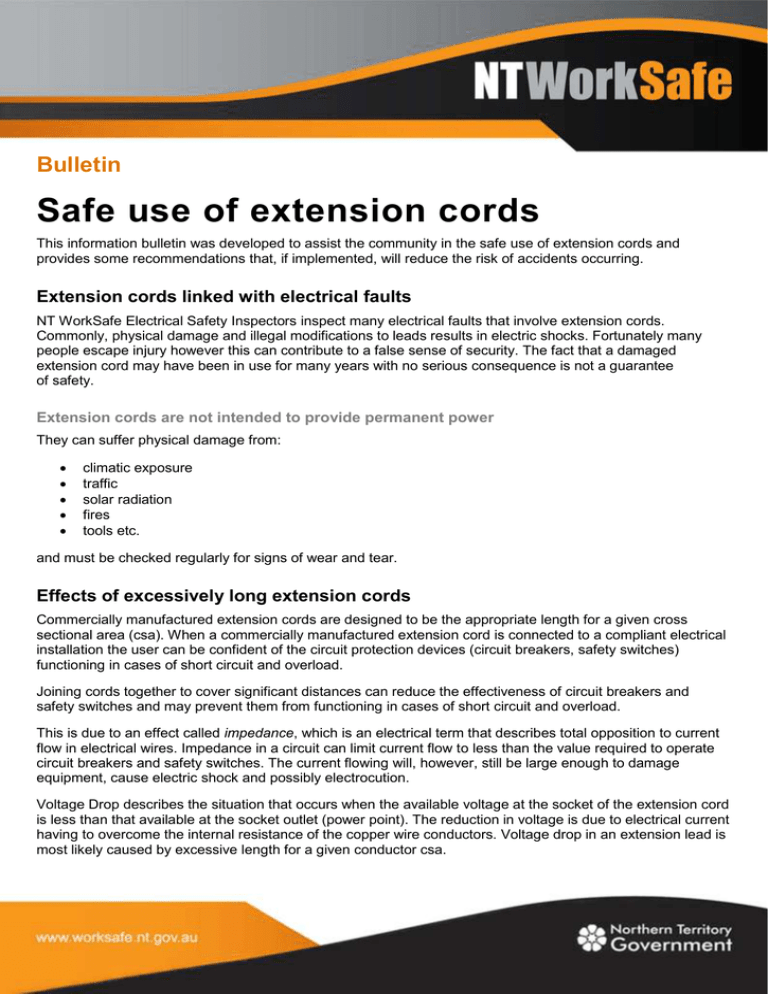
Bulletin Safe use of extension cords This information bulletin was developed to assist the community in the safe use of extension cords and provides some recommendations that, if implemented, will reduce the risk of accidents occurring. Extension cords linked with electrical faults NT WorkSafe Electrical Safety Inspectors inspect many electrical faults that involve extension cords. Commonly, physical damage and illegal modifications to leads results in electric shocks. Fortunately many people escape injury however this can contribute to a false sense of security. The fact that a damaged extension cord may have been in use for many years with no serious consequence is not a guarantee of safety. Extension cords are not intended to provide permanent power They can suffer physical damage from: climatic exposure traffic solar radiation fires tools etc. and must be checked regularly for signs of wear and tear. Effects of excessively long extension cords Commercially manufactured extension cords are designed to be the appropriate length for a given cross sectional area (csa). When a commercially manufactured extension cord is connected to a compliant electrical installation the user can be confident of the circuit protection devices (circuit breakers, safety switches) functioning in cases of short circuit and overload. Joining cords together to cover significant distances can reduce the effectiveness of circuit breakers and safety switches and may prevent them from functioning in cases of short circuit and overload. This is due to an effect called impedance, which is an electrical term that describes total opposition to current flow in electrical wires. Impedance in a circuit can limit current flow to less than the value required to operate circuit breakers and safety switches. The current flowing will, however, still be large enough to damage equipment, cause electric shock and possibly electrocution. Voltage Drop describes the situation that occurs when the available voltage at the socket of the extension cord is less than that available at the socket outlet (power point). The reduction in voltage is due to electrical current having to overcome the internal resistance of the copper wire conductors. Voltage drop in an extension lead is most likely caused by excessive length for a given conductor csa. For example: A number of typical light duty extension cords joined together to run 100 metres, and supplying a 10 amp load could suffer a 47 volt voltage drop (loss). This means 240 – 47 = 193 volts. Thus, 193 volts will be available from the far end of the cord instead of the 240 volts at the power point. All single phase appliances and power tools used in Australia are designed to run on 220-240 volts. Trying to run a power tool or appliance on significantly reduced voltage could cause the item to fail, resulting in a significant repair or replacement bill. The voltage that is lost in the extension cord is converted into heat. Excessive heat can cause failure of insulation and ultimately fire. NEVER, NEVER, NEVER MODIFY EXTENSION CORDS Modified extension cords are a serious contributing factor to many electrical faults. Acquire the appropriate extension cord suitable for the job, it is simply not worth the risk to try and adapt one to suit your requirements. As with an appliance, the earth pin & earth socket in an extension cord varies in size for very important reasons. Different size pins are created as a means of preventing extension cords being used to connect appliances of an incompatible rating to a circuit. Modifying the earth pin to connect an incompatible appliance can create a safety hazard and place persons at risk of electric shock or electrocution. Remember – if using extension cords ensure that they are: only used as an interim measure, in areas where they are not subject to damage the required length and capacity for the job to be done not modified in any way well maintained and regularly examined for signs of wear and tear, and if required by legislation, they are tested and tagged by qualified persons disconnected and stored appropriately until needed for the next job. Contact us For further information please contact us on 1800 019 115, facsimile (08) 8999 5141, via email at ntworksafe@nt.gov.au or go to the NT WorkSafe website at www.worksafe.nt.gov.au 2 Safe use of extension cords (V1.1 – 9 November 2011)
